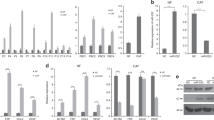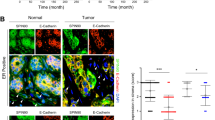Abstract
The tumor microenvironment has an important role in cancer progression. Here we show that miR-148a is downregulated in 15 out of 16 samples (94%) of cancer-associated fibroblasts (CAFs) compared with matched normal tissue fibroblasts (NFs) established from patients with endometrial cancer. Laser-capture microdissection of stromal cells from normal tissue and endometrial cancer confirmed this observation. Treatment of cells with 5-aza-deoxycytidine stimulated the expression of miR-148a in the majority of CAFs implicating DNA methylation in the regulation of miR-148a expression. Investigation of miR-148a function in fibroblasts demonstrated that conditioned media (CM) from CAFs overexpressing miR-148a significantly impaired the migration of five endometrial cancer cell lines without affecting their growth rates in co-culture experiments. Among predicted miR-148a target genes are two WNT family members, WNT1 and WNT10B. Activation of the WNT/β-catenin pathway in CAFs was confirmed by microarray analysis of gene expression and increased activity of the SuperTOPFlash luciferase reporter. We found elevated levels of WNT10B protein in CAFs and its level decreased when miR-148a was re-introduced by lentiviral infection. The 3′-UTR of WNT10B, cloned downstream of luciferase cDNA, suppressed luciferase activity when co-expressed with miR-148a indicating that WNT10B is a direct target of miR-148a. In contrast to the effect of miR-148a, WNT10B stimulated migration of endometrial cancer cell lines. Our findings have defined a molecular mechanism in the tumor microenvironment that is a novel target for cancer therapy.
This is a preview of subscription content, access via your institution
Access options
Subscribe to this journal
Receive 50 print issues and online access
$259.00 per year
only $5.18 per issue
Buy this article
- Purchase on Springer Link
- Instant access to full article PDF
Prices may be subject to local taxes which are calculated during checkout







Similar content being viewed by others
References
Bissell MJ, Radisky D . Putting tumours in context. Nat Rev Cancer 2001; 1: 46–54.
Polyak K, Haviv I, Campbell IG . Co-evolution of tumor cells and their microenvironment. Trends Genet 2009; 25: 30–38.
Kalluri R, Zeisberg M . Fibroblasts in cancer. Nat Rev Cancer 2006; 6: 392–401.
Aguirre-Ghiso JA . Models, mechanisms and clinical evidence for cancer dormancy. Nat Rev Cancer 2007; 7: 834–846.
Kuperwasser C, Chavarria T, Wu M, Magrane G, Gray JW, Carey L et al. Reconstruction of functionally normal and malignant human breast tissues in mice. Proc Natl Acad Sci USA 2004; 101: 4966–4971.
Cardone A, Tolino A, Zarcone R, Borruto Caracciolo G, Tartaglia E . Prognostic value of desmoplastic reaction and lymphocytic infiltration in the management of breast cancer. Panminerva Med 1997; 39: 174–177.
Kellermann MG, Sobral LM, da Silva SD, Zecchin KG, Graner E, Lopes MA et al. Mutual paracrine effects of oral squamous cell carcinoma cells and normal oral fibroblasts: induction of fibroblast to myofibroblast transdifferentiation and modulation of tumor cell proliferation. Oral Oncol 2008; 44: 509–517.
Olumi AF, Grossfeld GD, Hayward SW, Carroll PR, Tlsty TD, Cunha GR . Carcinoma-associated fibroblasts direct tumor progression of initiated human prostatic epithelium. Cancer Res 1999; 59: 5002–5011.
Orimo A, Gupta PB, Sgroi DC, Arenzana-Seisdedos F, Delaunay T, Naeem R et al. Stromal fibroblasts present in invasive human breast carcinomas promote tumor growth and angiogenesis through elevated SDF-1/CXCL12 secretion. Cell 2005; 121: 335–348.
Sneddon JB, Zhen HH, Montgomery K, van de Rijn M, Tward AD, West R et al. Bone morphogenetic protein antagonist gremlin 1 is widely expressed by cancer-associated stromal cells and can promote tumor cell proliferation. Proc Natl Acad Sci USA 2006; 103: 14842–14847.
Hill R, Song Y, Cardiff RD, Van Dyke T . Selective evolution of stromal mesenchyme with p53 loss in response to epithelial tumorigenesis. Cell 2005; 123: 1001–1011.
Kiaris H, Chatzistamou I, Trimis G, Frangou-Plemmenou M, Pafiti-Kondi A, Kalofoutis A . Evidence for nonautonomous effect of p53 tumor suppressor in carcinogenesis. Cancer Res 2005; 65: 1627–1630.
Patocs A, Zhang L, Xu Y, Weber F, Caldes T, Mutter GL et al. Breast-cancer stromal cells with TP53 mutations and nodal metastases. N Engl J Med 2007; 357: 2543–2551.
Allinen M, Beroukhim R, Cai L, Brennan C, Lahti-Domenici J, Huang H et al. Molecular characterization of the tumor microenvironment in breast cancer. Cancer Cell 2004; 6: 17–32.
Qiu W, Hu M, Sridhar A, Opeskin K, Fox S, Shipitsin M et al. No evidence of clonal somatic genetic alterations in cancer-associated fibroblasts from human breast and ovarian carcinomas. Nat Genet 2008; 40: 650–655.
Walter K, Omura N, Hong SM, Griffith M, Goggins M . Pancreatic cancer associated fibroblasts display normal allelotypes. Cancer Biol Ther 2008; 7: 882–888.
Fiegl H, Millinger S, Goebel G, Muller-Holzner E, Marth C, Laird PW et al. Breast cancer DNA methylation profiles in cancer cells and tumor stroma: association with HER-2/neu status in primary breast cancer. Cancer Res 2006; 66: 29–33.
Hu M, Yao J, Cai L, Bachman KE, van den Brule F, Velculescu V et al. Distinct epigenetic changes in the stromal cells of breast cancers. Nat Genet 2005; 37: 899–905.
Jiang L, Gonda TA, Gamble MV, Salas M, Seshan V, Tu S et al. Global hypomethylation of genomic DNA in cancer-associated myofibroblasts. Cancer Res 2008; 68: 9900–9908.
Ambros V . microRNAs: tiny regulators with great potential. Cell 2001; 107: 823–826.
Bartel DP . MicroRNAs: genomics, biogenesis, mechanism, and function. Cell 2004; 116: 281–297.
Di Leva G, Croce CM . Roles of small RNAs in tumor formation. Trends Mol Med 2010; 16: 257–267.
Aprelikova O, Yu X, Palla J, Wei BR, John S, Yi M et al. The role of miR-31 and its target gene SATB2 in cancer-associated fibroblasts. Cell Cycle 2010; 9: 4387–4398.
Olson P, Lu J, Zhang H, Shai A, Chun MG, Wang Y et al. MicroRNA dynamics in the stages of tumorigenesis correlate with hallmark capabilities of cancer. Genes Dev 2009; 23: 2152–2165.
Budhu A, Jia HL, Forgues M, Liu CG, Goldstein D, Lam A et al. Identification of metastasis-related microRNAs in hepatocellular carcinoma. Hepatology 2008; 47: 897–907.
Lujambio A, Calin GA, Villanueva A, Ropero S, Sanchez-Cespedes M, Blanco D et al. A microRNA DNA methylation signature for human cancer metastasis. Proc Natl Acad Sci USA 2008; 105: 13556–13561.
Zheng B, Liang L, Wang C, Huang S, Cao X, Zha R et al. MicroRNA-148a Suppresses Tumor Cell Invasion and Metastasis by Downregulating ROCK1 in Gastric Cancer. Clin Cancer Res 2011; 12: 7574–7583.
Hanoun N, Delpu Y, Suriawinata AA, Bournet B, Bureau C, Selves J et al. The silencing of microRNA 148a production by DNA hypermethylation is an early event in pancreatic carcinogenesis. Clin Chem 2010; 56: 1107–1118.
Klapholz-Brown Z, Walmsley GG, Nusse YM, Nusse R, Brown PO . Transcriptional program induced by Wnt protein in human fibroblasts suggests mechanisms for cell cooperativity in defining tissue microenvironments. PLoS One 2007; 2: e945.
Yi M, Stephens RMSLEPR . a sample-level enrichment-based pathway ranking method — seeking biological themes through pathway-level consistency. PLoS One 2008; 3: e3288.
Yoshikawa H, Matsubara K, Zhou X, Okamura S, Kubo T, Murase Y et al. WNT10B functional dualism: beta-catenin/Tcf-dependent growth promotion or independent suppression with deregulated expression in cancer. Mol Biol Cell 2007; 18: 4292–4303.
Tchernitsa O, Kasajima A, Schafer R, Kuban RJ, Ungethum U, Gyorffy B et al. Systematic evaluation of the miRNA-ome and its downstream effects on mRNA expression identifies gastric cancer progression. J Pathol 2010; 222: 310–319.
Endo Y, Wolf V, Muraiso K, Kamijo K, Soon L, Uren A et al. Wnt-3a-dependent cell motility involves RhoA activation and is specifically regulated by dishevelled-2. J Biol Chem 2005; 280: 777–786.
Kikuchi A, Yamamoto H . Tumor formation due to abnormalities in the beta-catenin-independent pathway of Wnt signaling. Cancer Sci 2008; 99: 202–208.
Scheel C, Eaton EN, Li SH, Chaffer CL, Reinhardt F, Kah KJ et al. Paracrine and autocrine signals induce and maintain mesenchymal and stem cell states in the breast. Cell 2011; 145: 926–940.
Risinger JI, Maxwell GL, Chandramouli GV, Aprelikova O, Litzi T, Umar A et al. Gene expression profiling of microsatellite unstable and microsatellite stable endometrial cancers indicates distinct pathways of aberrant signaling. Cancer Res 2005; 65: 5031–5037.
Carmon KS, Loose DS . Secreted frizzled-related protein 4 regulates two Wnt7a signaling pathways and inhibits proliferation in endometrial cancer cells. Mol Cancer Res 2008; 6: 1017–1028.
Hecht JL, Mutter GL . Molecular and pathologic aspects of endometrial carcinogenesis. J Clin Oncol 2006; 24: 4783–4791.
Konopka B, Janiec-Jankowska A, Czapczak D, Paszko Z, Bidzinski M, Olszewski W et al. Molecular genetic defects in endometrial carcinomas: microsatellite instability, PTEN and beta-catenin (CTNNB1) genes mutations. J Cancer Res Clin Oncol 2007; 133: 361–371.
Moreno-Bueno G, Hardisson D, Sanchez C, Sarrio D . Cassia R, Garcia-Rostan G, et al. Abnormalities of the APC/beta-catenin pathway in endometrial cancer. Oncogene 2002; 21: 7981–7990.
Saegusa M, Okayasu I . Frequent nuclear beta-catenin accumulation and associated mutations in endometrioid-type endometrial and ovarian carcinomas with squamous differentiation. J Pathol 2001; 194: 59–67.
Scholten AN, Creutzberg CL, van den Broek LJ, Noordijk EM, Smit VT . Nuclear beta-catenin is a molecular feature of type I endometrial carcinoma. J Pathol 2003; 201: 460–465.
Lane TF, Leder P . Wnt-10b directs hypermorphic development and transformation in mammary glands of male and female mice. Oncogene 1997; 15: 2133–2144.
Chen K, Fallen S, Abaan HO, Hayran M, Gonzalez C, Wodajo F et al. Wnt10b induces chemotaxis of osteosarcoma and correlates with reduced survival. Pediatr Blood Cancer 2008; 51: 349–355.
Ross SE, Hemati N, Longo KA, Bennett CN, Lucas PC, Erickson RL et al. Inhibition of adipogenesis by Wnt signaling. Science 2000; 289: 950–953.
Qin L, Chen Y, Niu Y, Chen W, Wang Q, Xiao S et al. A deep investigation into the adipogenesis mechanism: profile of microRNAs regulating adipogenesis by modulating the canonical Wnt/beta-catenin signaling pathway. BMC Genomics 2010; 11: 320.
Song YX, Yue ZY, Wang ZN, Xu YY, Luo Y, Xu HM et al. MicroRNA-148b is frequently down-regulated in gastric cancer and acts as a tumor suppressor by inhibiting cell proliferation. Mol Cancer 2011; 10: 1.
Wei J, Melichian D, Komura K, Hinchcliff M, Lam AP, Lafyatis R et al. Canonical Wnt signaling induces skin fibrosis and subcutaneous lipoatrophy: A novel mouse model for scleroderma? Arthritis Rheum 2011; 63: 1707–1717.
Nagendra DC, Burke J, Maxwell GL, Risinger JI . PPP2R1A mutations are common in the serous type of endometrial cancer. Mol Carcinog (e-pub ahead of priant 31 August 2011; doi:10.1002/mc.20850).
Uren A, Reichsman F, Anest V, Taylor WG, Muraiso K, Bottaro DP et al. Secreted frizzled-related protein-1 binds directly to Wingless and is a biphasic modulator of Wnt signaling. J Biol Chem 2000; 275: 4374–4382.
Acknowledgements
We thank Julie Oliver, Tracy Litzi, and Shelley Hoover for help with laser capture microdissection, Dr Xin Wei Wang (NCI) for the WNT10B expression vector and Dr Randall Moon (University of Washington) for the SuperTOPFlash and SuperFOPFlash constructs. This work was supported by the Intramural Research Program of National Institutes of Health, National Cancer Institute, and Center for Cancer Research.
Author information
Authors and Affiliations
Corresponding authors
Ethics declarations
Competing interests
The authors declare no conflict of interest.
Additional information
Supplementary Information accompanies the paper on the Oncogene website
Supplementary information
Rights and permissions
About this article
Cite this article
Aprelikova, O., Palla, J., Hibler, B. et al. Silencing of miR-148a in cancer-associated fibroblasts results in WNT10B-mediated stimulation of tumor cell motility. Oncogene 32, 3246–3253 (2013). https://doi.org/10.1038/onc.2012.351
Received:
Revised:
Accepted:
Published:
Issue Date:
DOI: https://doi.org/10.1038/onc.2012.351
Keywords
This article is cited by
-
Rapid purification and multiparametric characterization of circulating small extracellular vesicles utilizing a label-free lab-on-a-chip device
Scientific Reports (2023)
-
Fibronectin mediates activation of stromal fibroblasts by SPARC in endometrial cancer cells
BMC Cancer (2021)
-
Signaling pathways in cancer-associated fibroblasts and targeted therapy for cancer
Signal Transduction and Targeted Therapy (2021)
-
The tumor microenvironment as driver of stemness and therapeutic resistance in breast cancer: New challenges and therapeutic opportunities
Cellular Oncology (2021)
-
The promising role of noncoding RNAs in cancer-associated fibroblasts: an overview of current status and future perspectives
Journal of Hematology & Oncology (2020)



